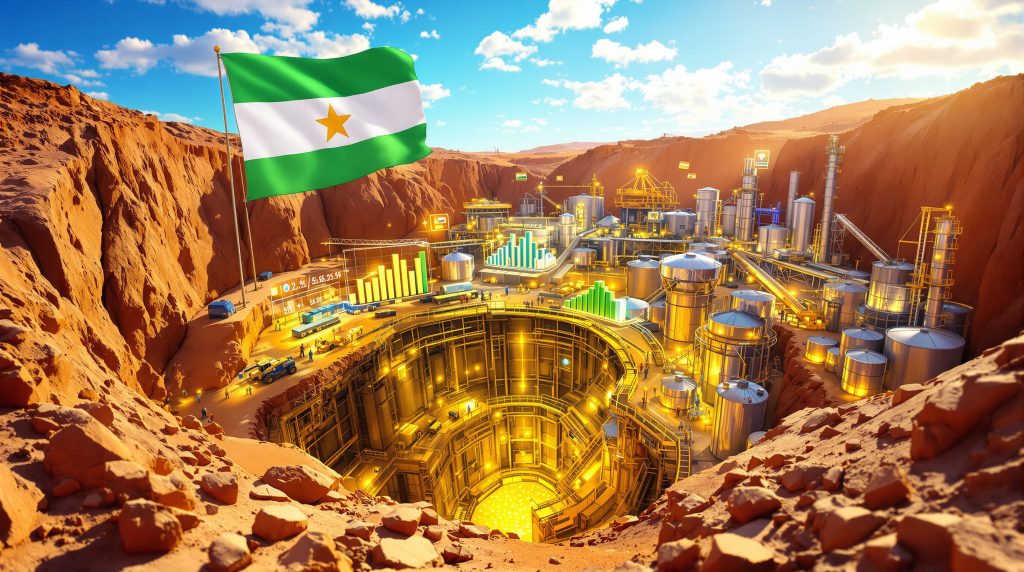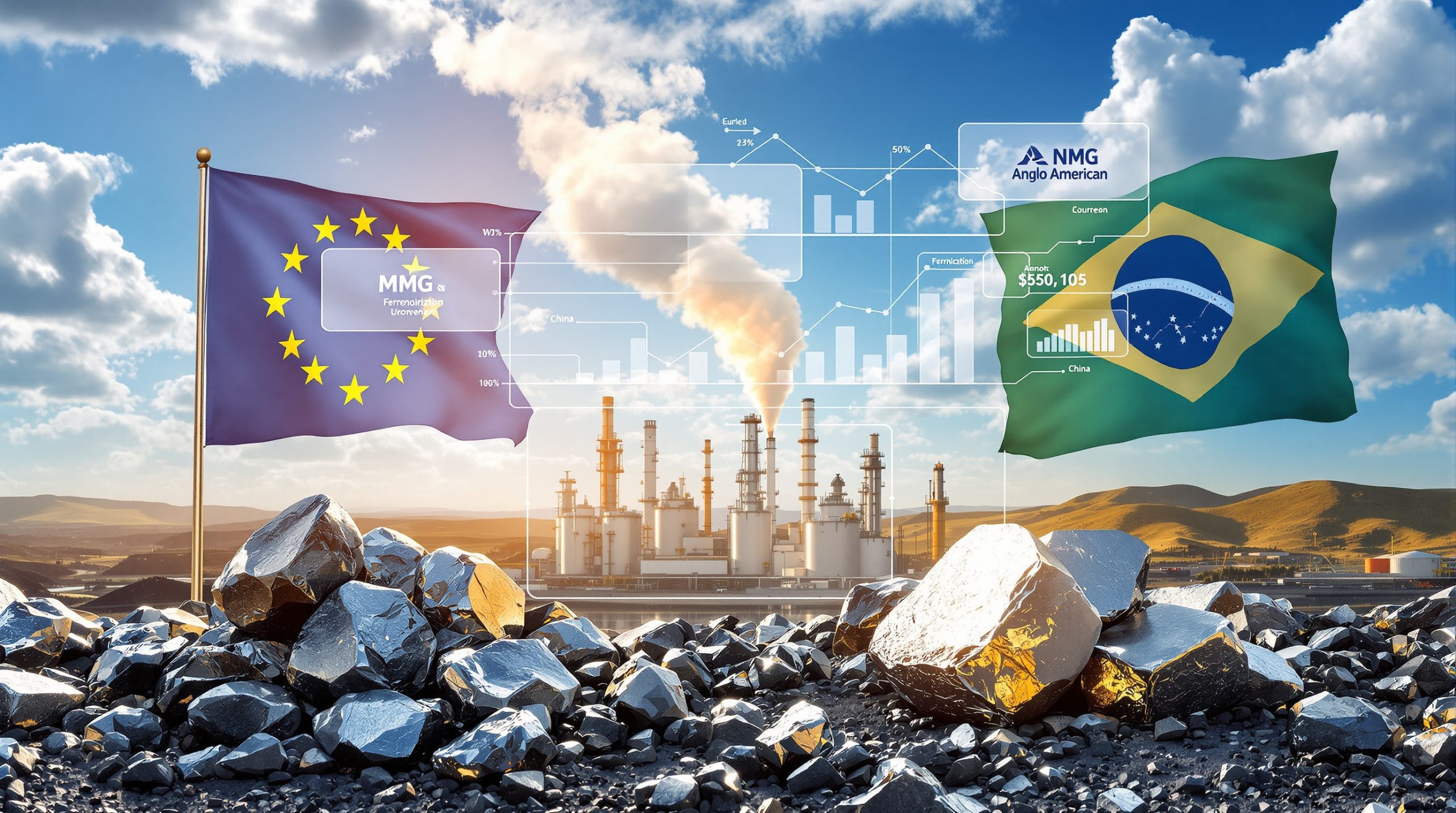How Does the Dasa Project Compare to Other Global Uranium Developments?
The Global Atomic Niger uranium project stands as a remarkable development in the global uranium landscape, distinguished by ore grades that reach 5,109 parts per million during initial production phases. This exceptional concentration positions the Dasa deposit among the most significant high-grade uranium resources outside Canada's prestigious Athabasca Basin region. Furthermore, the project's unique positioning becomes even more significant considering recent developments such as the Paladin Energy Namibia halt and ongoing uranium market volatility.
Project Scale and Resource Quality
Key Technical Specifications:
- Annual production target: 3 million pounds of uranium oxide
- Total reserve estimate: 68.1 million pounds over 23-year operational life
- Processing capacity: 1,000-1,200 tonnes per day throughput
- Mine development: Over 1,200 meters of underground advancement completed
The project's resource quality becomes evident when compared to global uranium deposit standards. While Canada's Athabasca Basin deposits like Cigar Lake exceed 150,000 parts per million, representing the world's highest-grade uranium resources, the Dasa project's 5,109 ppm places it significantly above the global average for economically viable uranium deposits, which typically range from 1,000 to 3,000 ppm.
Ownership Structure and Government Partnership
A distinctive feature of the Global Atomic Niger uranium project lies in its ownership configuration, where Global Atomic maintains an 80% controlling stake while the Government of Niger holds the remaining 20% interest. This partnership structure creates fundamental alignment between project success and national economic objectives, providing a differentiated position compared to entirely foreign-owned mining operations throughout the region.
This government participation model offers strategic advantages during periods of political transition or resource nationalism trends. The structure ensures that project success directly benefits Niger's national treasury, creating inherent protection against nationalisation initiatives that have affected other international mining operations in West Africa.
What Infrastructure Developments Support Project Advancement?
Construction Progress and Timeline Updates
Development activities have progressed substantially through 2025, with underground mining operations formally commenced following the inaugural blast ceremony in November 2022. The infrastructure advancement encompasses multiple critical components necessary for full-scale uranium production operations.
Current Development Status:
- More than 1,200 meters of mine development completed
- Approximately 10,000 tonnes of development ore extracted and stockpiled
- Processing plant earthworks nearing completion
- Concrete batch plant construction underway
- Camp facilities advancing to accommodate 900 construction workers
The underground development demonstrates significant technical achievement, with multiple mining levels established to access the uranium-bearing ore zones. The extraction of development ore during construction phases provides valuable material for plant commissioning and initial production testing, representing standard practice for underground mining operations transitioning from development to production.
Processing Technology and Production Systems
The processing facility employs conventional sulfuric acid leaching methodology, representing approximately 60% of global uranium processing approaches. This technology selection provides operational reliability and proven performance across diverse uranium ore types, ensuring predictable recovery rates and product quality specifications.
The complete flow sheet incorporates crushing, grinding, leaching, and precipitation stages designed to produce uranium oxide concentrate meeting international nuclear fuel fabrication specifications. In addition, the facility design includes initial throughput capacity of 1,000 tonnes per day with engineering provisions to handle up to 1,200 tonnes daily, providing operational flexibility to respond to market conditions and ore characteristics.
Processing Infrastructure Components:
| Component | Specification | Status |
|---|---|---|
| Primary Crusher | 1,000-1,200 tpd capacity | Under construction |
| Mill Circuit | Conventional ball mill design | Equipment delivered |
| Leach Tanks | Sulfuric acid leaching system | Civil works complete |
| Precipitation Plant | Uranium oxide concentrate production | Foundation work ongoing |
How Does Niger's Political Environment Affect Project Development?
Government Support and Strategic Importance
Niger's leadership has provided explicit endorsement for the Dasa project, with government officials confirming its strategic economic significance through official correspondence and site visits. The country's mines minister conducted an official facility visit in May 2024, witnessing the company's commitment to local workforce development and regulatory compliance standards.
The government's 20% ownership stake creates direct financial incentive for project success, differentiating the Dasa development from purely foreign-owned operations that may face different political considerations during economic or political transitions. This is particularly relevant considering other regional developments, including the Patterson Corridor uranium project and various policy shifts such as the Nova Scotia uranium ban.
Regional Mining Context and Sovereignty Trends
Niger's uranium sector has experienced significant transitions, including the June 2025 nationalisation of the Somaïr uranium mine, previously operated through French joint venture arrangements. These developments reflect broader resource sovereignty initiatives across West Africa while highlighting the differentiated position of projects with government ownership participation.
The country has maintained continuous uranium mining operations for over 50 years, establishing robust regulatory frameworks and export infrastructure that support mining sector development. However, recent political changes have created new dynamics affecting international mining relationships.
Political Risk Considerations:
- Military leadership transition in July 2023
- Licence revocations affecting other international uranium developers in 2024
- Government's 20% ownership stake providing strategic protection
- Explicit statements confirming no nationalisation intentions for Dasa
The political environment requires careful monitoring, particularly given the challenges faced by other international uranium developers who experienced licence revocations in 2024. However, the Dasa project's government partnership and strategic economic importance provide meaningful differentiation from purely foreign-owned mining ventures.
What Financial Structure Supports Project Completion?
Recent Capital Raising and Investment Progress
Global Atomic completed a C$20 million bought deal public offering in October 2025, issuing 32,259,000 units at C$0.62 per unit. Each unit includes one common share and one warrant exercisable at C$0.80 within 36 months, providing structured equity financing with potential upside participation for investors.
This financing structure balances immediate capital requirements with investor participation in future value appreciation. The warrant exercise price represents approximately 29% premium to the unit price, requiring substantial project advancement or uranium market appreciation for warrant exercise to become economically attractive.
Financing Timeline and Requirements:
- Total corporate investment to date: Approximately $250 million
- Remaining project financing discussions: $295 million debt facility potential
- US Development Finance Corporation engagement ongoing
- 40% capital contribution requirement satisfied for institutional financing
The company's financing strategy demonstrates adherence to standard mining project development practices, where developer equity contribution typically represents 40-50% of total project costs, enabling institutional debt financing for remaining capital requirements. Furthermore, the Global Atomic Niger uranium project has attracted interest from the US Development Finance Corporation, indicating strong international support for the development.
Dual Revenue Model and Cash Flow Diversification
The company operates a complementary zinc recycling joint venture in Turkey, maintaining a 49% interest in Befesa Silvermet Turkey. This operation generated $4.1 million in EBITDA attributable to Global Atomic during the first nine months of 2025, providing geographic and commodity diversification during uranium project development.
This dual-revenue structure addresses investor concerns regarding single-asset development risk while providing cash flow during the uranium project construction phase. Consequently, the Turkish operation offers exposure to base metals markets while the Niger project provides uranium market participation, creating portfolio diversification within a single corporate structure.
Revenue Diversification Benefits:
- Reduced dependence on single-project execution risk
- Geographic diversification across Turkey and Niger
- Commodity diversification between zinc and uranium markets
- Ongoing cash flow during uranium project development
How Does Market Timing Influence Project Value?
Uranium Supply Constraints and Demand Fundamentals
Global uranium markets are experiencing structural supply constraints, with reactor requirements projected to exceed primary mine supply through 2035. World Nuclear Association data indicates growing demand pressure as existing reactor fleets continue operations while new nuclear construction accelerates globally. This situation is further compounded by the US Senate uranium ban on Russian imports, creating additional supply pressures.
Current global uranium production reaches approximately 62,200 tonnes annually, while reactor requirements continue expanding driven by nuclear capacity additions in the United States, Canada, and European Union nations. This supply-demand imbalance creates favourable market conditions for new uranium production sources entering the market during the mid-2020s timeframe.
Market Context Factors:
- Global production reaching approximately 62,200 tonnes annually
- Enrichment capacity expansion creating additional natural uranium demand
- Several anticipated mine startups facing development delays
- Premium pricing environment expected during supply tightness periods
The structural nature of these supply constraints results from multiple factors, including mine depletion at existing operations, regulatory challenges affecting new mine development, and increased uranium demand from both existing reactor operations and new nuclear construction programmes worldwide.
Offtake Agreements and Revenue Visibility
Global Atomic has secured offtake agreements covering 90% of anticipated production with major North American and European utilities. These arrangements establish revenue visibility ahead of production commencement while aligning with Western energy security objectives and supply chain diversification initiatives.
The offtake agreements provide pricing protection and revenue certainty, addressing investor concerns about uranium market volatility during the initial production years. For instance, these contracts typically include pricing mechanisms that capture uranium market upside while providing minimum price floors to protect project economics.
What Operational Excellence Metrics Define Project Performance?
Safety Record and Workforce Development
The mining operation has maintained zero lost-time incidents since underground mining commenced 779 days prior to October 2024. This safety performance demonstrates operational excellence and workforce competency, critical factors for sustainable mining operations in challenging environments.
The workforce composition is approximately 98% Nigerien, including experienced miners from former underground operations and local workers participating in company training programmes. This local workforce development approach supports community integration while reducing operational costs compared to expatriate-heavy mining operations.
Workforce Development Achievements:
- Zero lost-time incidents over 779 days of underground operations
- 98% Nigerien workforce composition
- Integration of experienced miners from regional mining operations
- Comprehensive training programmes for local workforce development
Community Integration and Local Economic Impact
Global Atomic has maintained continuous presence in Niger's Agadez and Tchirozérine regions since 2008, implementing comprehensive community programmes addressing food security, medical support, water infrastructure development, educational scholarships, and preferential local procurement initiatives.
This long-term community presence demonstrates commitment to sustainable mining practices and social licence maintenance. However, the company's approach addresses critical community needs while building relationships that support long-term operational stability.
Community Investment Areas:
- Local workforce development and training programmes
- Infrastructure improvements in surrounding communities
- Educational scholarship programmes for regional students
- Medical support and healthcare facility enhancements
- Water infrastructure development projects
What Expansion Opportunities Exist Beyond Dasa?
Additional Uranium Deposits and Exploration Potential
The company has identified three additional uranium deposits in Niger beyond Dasa that may advance with further assessment work. These exploration assets provide potential resource expansion opportunities beyond the current mine plan, though they remain early-stage prospects requiring substantial evaluation and development investment.
The exploration portfolio demonstrates the potential for extending the company's Niger operations beyond the current 23-year Dasa mine life. Nevertheless, these additional deposits require comprehensive geological evaluation, resource estimation, and economic assessment before advancing toward development decisions.
Regional Infrastructure and Processing Capabilities
Equipment delivery to the Dasa site has progressed through 2025, with processing plant components arriving via Nigeria following border restrictions between Niger and Benin. The established processing infrastructure may support future deposit development within the region, providing operational synergies for additional uranium projects.
The processing plant design incorporates flexibility for handling varying ore characteristics, potentially accommodating future deposits with different geological characteristics. Consequently, this infrastructure investment creates platform capabilities for regional uranium development beyond the initial Dasa project scope.
How Do Project Economics Compare to Industry Standards?
Financial Returns and Investment Metrics
The Dasa project demonstrates robust economic returns, delivering a 57% after-tax internal rate of return and $917 million net present value at $75 per pound uranium pricing. These metrics position Dasa among the highest-quality undeveloped uranium assets globally based on grade, scale, and capital efficiency.
The project's economic performance reflects the combination of exceptional ore grades, efficient processing technology, and strategic market timing. The internal rate of return significantly exceeds typical mining project thresholds of 15-20%, while the net present value indicates substantial value creation potential.
Economic Performance Indicators:
| Metric | Value |
|---|---|
| After-tax IRR | 57% |
| Net Present Value | $917 million |
| Uranium Price Assumption | $75/lb |
| Production Life | 23 years |
| Average Annual Production | 3 million lbs |
Capital Efficiency and Development Costs
The project's capital requirements reflect efficient development approaches, with total investment expectations remaining competitive relative to other greenfield uranium developments globally. The phased construction approach allows for capital deployment optimisation while maintaining development momentum toward the targeted 2026 production startup.
Capital efficiency metrics benefit from Niger's established mining infrastructure, available skilled workforce, and proximity to existing export corridors. These factors reduce infrastructure development costs compared to greenfield projects in less developed mining regions.
What Strategic Positioning Advantages Does Global Atomic Maintain?
Unique Market Position and Competitive Differentiation
Global Atomic represents the only greenfield uranium mine currently under active construction globally, providing unique exposure to supply-constrained market conditions expected through the mid-2020s. The combination of exceptional grades, established offtake agreements, and government partnership creates multiple competitive advantages unavailable to other uranium development projects.
This positioning provides investors with differentiated exposure to uranium market fundamentals without the execution risks associated with early-stage exploration or development projects. The advanced construction status reduces technical and permitting risks while maintaining upside exposure to uranium market appreciation.
Integration with Western Supply Chains
The Global Atomic Niger uranium project's alignment with US and European utility requirements addresses critical supply chain diversification objectives as nuclear power expansion accelerates. This positioning supports premium pricing potential while reducing reliance on geopolitically sensitive uranium sources that may face supply disruptions or trade restrictions.
The established offtake agreements with Western utilities demonstrate market acceptance and provide revenue security that supports project financing and long-term operational planning. This Western market integration differentiates the project from uranium sources that may face geopolitical constraints or supply chain limitations.
Strategic Advantages Summary:
- Only greenfield uranium project under construction globally
- Highest-grade deposit in Africa outside Athabasca Basin
- Government partnership providing operational stability
- Established offtake agreements with Western utilities
- Dual-revenue model reducing single-asset risk
- Experienced management team with regional expertise
"Niger strongly supports the Dasa uranium project but talks continue on financing," according to recent industry reports, highlighting the government's commitment to the development despite ongoing financing discussions.
Disclaimer: This analysis contains forward-looking statements and projections based on current market conditions and company disclosures. Uranium market dynamics, political developments in Niger, and project execution risks may materially affect actual outcomes. Investors should conduct independent due diligence and consider professional advice before making investment decisions.
The Global Atomic Niger uranium project represents a compelling combination of exceptional resource quality, strategic market timing, and operational advancement that positions it uniquely within the global uranium development landscape. The project's progression toward 2026 production startup during anticipated supply constraints creates significant value creation potential, while the government partnership and established offtake agreements provide operational stability and revenue certainty that differentiate it from other uranium development opportunities.
Ready to capitalise on the next major uranium discovery?
Discovery Alert instantly alerts investors to significant ASX mineral discoveries using its proprietary Discovery IQ model, turning complex mineral data into actionable insights. Understand why historic discoveries can generate substantial returns by visiting Discovery Alert's dedicated discoveries page, showcasing exceptional outcomes from previous mineral finds.




